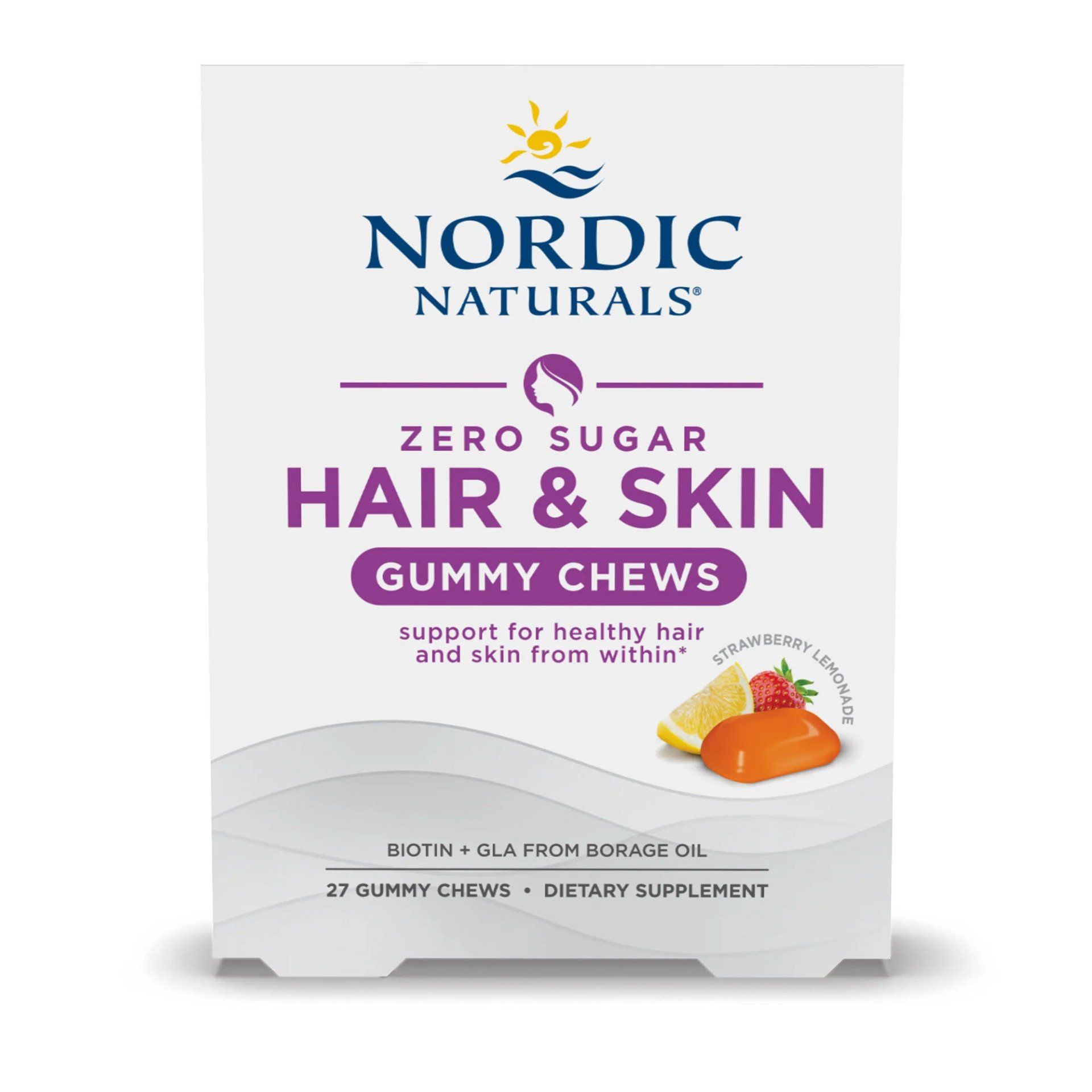Nutritional Support for Hair and Skin
Essential fatty acids have documented roles in both the dermal and epidermal layers of the skin, and a deficiency in these fats can affect skin function and appearance. More specifically, essential fatty acid deficiency can lead to skin conditions characterized by dry, itchy, and inflamed skin and increased moisture loss from within the layers of the skin.
Gamma linolenic acid (GLA) promotes a healthy balance of fats in the skin and the formation of inflammation-resolving molecules.1 At clinical doses, GLA supplementation can promote skin hydration, increase skin elasticity and firmness, improve the appearance of dry skin, and decrease the appearance of redness and skin imperfections.7-10
Skin health is also strongly influenced by biotin, a vitamin essential for human health. Also known as vitamin B7 or vitamin H, biotin plays a key role in the metabolism of fats, proteins, and carbohydrates. Clinical signs of biotin deficiency include skin rash, itching, and hair loss.11 This has led some dermatologists to recommend biotin as a nutritional supplement for hair and skin.12 Indeed, studies show that biotin supplementation can promote hair growth and skin health in instances of biotin deficiency.13,14
Supplements for Skin and Hair Health
- Gamma linolenic acid (GLA) is a long-chain fatty acid belonging to the omega-6 family of polyunsaturated fats. It derives from linoleic acid (LA)—an essential fatty acid with implications for cellular signaling, brain function, skin health, and more.16 GLA is classified as “conditionally essential”, meaning that it can become essential if an individual lacks the enzyme needed to convert LA to GLA, or is unable to efficiently convert LA to GLA.
- Borage oil derives from the seeds of the borage plant (Borago officinalis), a large plant with blue, star-shaped flowers found throughout Europe and North Africa and naturalized to North America. Out of all primary sources of GLA available, borage oil contains the highest amount of naturally occurring GLA, making it ideal for dietary supplementation.15
- Biotin is a B vitamin (B7) required for processes involved in energy metabolism, such as the synthesis of fatty acids, and conversion of non-carbohydrates into glucose.18 Biotin also aids in the breakdown of fat and helps metabolize carbohydrates and amino acids. These functions make biotin an important part of creating the energy humans need.18 Although biotin deficiency is relatively rare, certain metabolic conditions can impede the body’s metabolism or uptake of biotin, making supplementation advisable.13,18 Other factors, including pregnancy, lactation, malnutrition, advanced age, exercise, and habitual alcohol consumption can also lead to low biotin levels that may benefit from supplementation.18-21

ZERO SUGAR HAIR & SKIN GUMMY CHEWS
SUPPORT FOR SKIN AND HEALTHY HAIR FROM WITHIN*
• Essential support for skin and hair in a delicious gummy*
• Pairs well with other omega-3 and GLA products
• Promote a healthy balance of fats in the skin*
• Promotes the resolution of cellular stress in the skin*
• Support healthy hair*
• No artificial coloring, flavoring, and preservatives
1. Linus Pauling Institute. Essential Fatty Acids. Oregon State University.
2. Simopoulos AP. Biomed Pharmacother. 2002. 56(8): p. 365–79.
3. Fan Y-Y, Chapkin RS. J Nutr. 1998. 128(9): p. 1411-1414.
4. Belch JJ, Hill A. Am J Clin Nutr. 2000. 71 (1 Suppl): 352S–6S.
5. Guivernau M, et al. Prostaglandins Leukot Essent Fatty Acids. 1994. 51 (5): p. 311–6.
6. Palombo JD, et al. JPEN J Parenter Enteral Nutr. 1997. 21(3): p. 123-32.
7. Muggli, R. Int J Cosmet Sci. 2005. 27(4): p. 243-9.
8. De Spirt S, et al. Br J Nutr. 2009. 101(3): p. 440-5.
9. Brosche T, Platt D. Arch Gerontol Geriatr. 2000. 30(2): p. 139-50.
10. Kawamura A, et al. J Oleo Sci. 2011. 60(12): p. 597-607.
11. Dietary Reference Intakes for Thiamin, Riboflavin, Niacin, Vitamin B6, Folate, Vitamin B12, Pantothenic Acid, Biotin, and Choline. 1998: Washington (DC).
12. Dickinson A, et al. Nutr J. 2011. 10: p. 20.
13. Patel DP, et al. Skin Appendage Disord. 2017. 3(3): p. 166-169.
14. Iikura Y, et al. Acta Paediatr Scand. 1988. 77(5): p. 762-3.
15. SanGiovanni JP, Chew EY. Prog Retin Eye Res. 2005. 24(1): p. 87-138.
16. Guivernau M, et al. Prostaglandins Leukot Essent Fatty Acids. 1994. 51(5): p. 311–6.
17. Palombo JD, et al. JPEN J Parenter Enteral Nutr. 1997. 21(3): p. 123-32.
18. Trüeb RM. Int J Trichology. 2016. 8(2): p. 73-77.
19. Subramanya SB, et al. Am J Physiol Gastrointest Liver Physiol. 2011. 300: G494–501.
20. Sealey WM, et al. Am J Clin Nutr. 2004. 80: p. 932–5.
21. Mock DM, et al. Am J Clin Nutr. 2002. 75: p. 295–9









